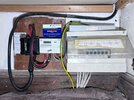- Joined
- 23 Jan 2024
- Messages
- 3
- Reaction score
- 0
- Country

Just moved into a 4 bed house. We will over time need some adaptions for sockets and switches as it's a 1932 property which needs some modernisation throughout.
The consumer unit is in the bedroom which is unusual, but we have overhead power coming into the property.
Had a sparky round today as I wanted to spur off a double socket for another double behind wall mounted tv eventually. He said that the consumer unit would need changing to meet latest regs BUT would be better to rewire the whole house and start again?
What started as a cheap job - has left me this evening pondering £000's of work and mess.
Just wanted the thoughts of others or sparkies who can clarify so I can work out what to do next.
The consumer unit is in the bedroom which is unusual, but we have overhead power coming into the property.
Had a sparky round today as I wanted to spur off a double socket for another double behind wall mounted tv eventually. He said that the consumer unit would need changing to meet latest regs BUT would be better to rewire the whole house and start again?
What started as a cheap job - has left me this evening pondering £000's of work and mess.
Just wanted the thoughts of others or sparkies who can clarify so I can work out what to do next.


